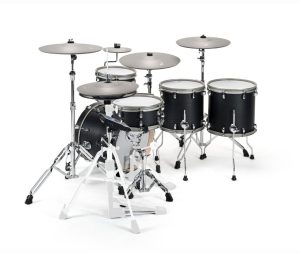Uncategorized
How to Get Started with Electronic Music Instruments
How to Get Started with Electronic Music Instruments
Electronic music has revolutionized the music industry, providing musicians with a vast array of tools to create unique sounds and experiment with new genres. From synthesizers and drum machines to electronic drum kits and digital audio workstations (DAWs), electronic music instruments offer a world of possibilities. Whether you’re an aspiring producer, DJ, or just a music enthusiast, getting started with electronic music instruments can seem daunting. However, with the right guidance, you can easily dive into this exciting world and start creating your own music.
In this article, we’ll guide you through the essential steps and tips on how to get started with electronic music instruments, focusing on the basics, key equipment, and useful resources to help you build your skills and knowledge.

1. Understand the Basics of Electronic Music
Before jumping into the gear and software, it’s important to grasp the basic concepts behind electronic music. Understanding the fundamental components of electronic music production, such as beats, melodies, effects, and synthesis, will give you a solid foundation to build on.
- Beats and Rhythm: In electronic music, beats are the backbone of the track. Whether you’re creating techno, house, or trap, beats set the tempo and structure of the song.
- Melodies and Harmonies: Electronic instruments allow for precise control over melodies, chords, and harmonies. Synthesizers, in particular, enable you to create complex soundscapes and musical progressions.
- Effects: Effects such as reverb, delay, and modulation are key to shaping the overall sound of electronic music. These are often used creatively to add atmosphere, depth, and movement to the track.
Getting familiar with these concepts will help you better understand how electronic instruments fit into the broader picture of music creation.
2. Start with the Right Equipment
When starting out with electronic music, it’s essential to have the right tools. Fortunately, electronic music instruments come in a variety of shapes, sizes, and price points, so there’s something for every budget. Below are the most common types of equipment you’ll need to begin creating electronic music:
a) Digital Audio Workstation (DAW)
A DAW is the software where you will compose, edit, mix, and produce your music. It’s the heart of electronic music production, as it allows you to record, arrange, and manipulate sounds. Some popular DAWs for beginners include:
- Ableton Live: Known for its user-friendly interface and real-time music creation features, Ableton is widely used by electronic music producers.
- FL Studio: Another great DAW for beginners, FL Studio offers a simple interface with powerful tools for creating beats and melodies.
- Logic Pro X: Ideal for those who want a professional-grade DAW, Logic Pro X is perfect for music production across various genres, including electronic music.
b) MIDI Controller
A MIDI controller is a device that allows you to control your DAW and software instruments (like synthesizers and samplers) using physical keys, pads, or knobs. It doesn’t generate sound on its own but communicates with your computer to trigger sounds in your DAW. Popular MIDI controllers include:
- Akai MPK Mini: A compact MIDI keyboard that’s perfect for beginners. It includes pads and knobs that allow you to control a range of parameters in your DAW.
- Novation Launchkey: A slightly larger keyboard with additional features, perfect for those looking to dive deeper into music production.
c) Audio Interface
An audio interface is necessary for connecting your electronic instruments (like synthesizers, drum machines, or microphones) to your computer. It ensures that the audio signals are converted into digital data that can be processed by your DAW.
- Focusrite Scarlett 2i2: This is one of the most popular audio interfaces for beginners due to its high-quality sound and affordable price.
- PreSonus AudioBox: Another great option, the PreSonus AudioBox is easy to use and offers solid audio performance.
d) Headphones or Studio Monitors
Good headphones or studio monitors are essential for accurately hearing your music and making informed decisions while mixing. Studio monitors are designed to give you a flat frequency response, so you can hear your music without color or distortion.
- Audio-Technica ATH-M50x: A pair of headphones that are widely recommended for beginners and professionals alike due to their clear sound and durable build.
- Yamaha HS5: A great pair of studio monitors for entry-level producers. They provide an accurate representation of your sound and are highly regarded in the music industry.
3. Learn How to Use Software Synthesizers
A large part of electronic music production involves synthesizers, which are used to create a wide range of sounds, from deep bass to airy pads and lead lines. Software synthesizers, or VSTs (Virtual Studio Technology), are digital versions of hardware synthesizers that you can use within your DAW.
Here are some popular VST synthesizers for beginners:
- Serum: Known for its high-quality sound and ease of use, Serum is an excellent choice for both beginners and advanced producers.
- Sylenth1: A classic synth that’s been used in countless productions. It’s known for its lush sound and intuitive interface.
- Massive: Another highly regarded synth that is great for producing bass-heavy sounds, ideal for genres like dubstep and electro.
Experiment with these synthesizers and learn how to tweak the different parameters such as oscillators, filters, and envelopes to shape your sounds.
4. Explore Drum Machines and Samplers
Drum machines and samplers are fundamental to creating beats in electronic music. A drum machine is a device that allows you to create beats and rhythms using pre-recorded or synthesized sounds. Samplers, on the other hand, enable you to manipulate recorded audio clips or sounds.
Popular Drum Machines and Samplers:
- Roland TR-8S: This is a modern version of the legendary Roland drum machines, perfect for electronic music producers.
- Native Instruments Maschine: A highly versatile sampler and drum machine combo that allows you to create complex beats and samples.
Many DAWs come with built-in drum kits, but investing in a hardware or software drum machine can expand your creative possibilities.

5. Start Experimenting and Creating
Once you’ve got the essential equipment, it’s time to start experimenting. Here’s a quick guide to get you started:
- Start with a Beat: Create a simple drum pattern using your DAW or drum machine. Experiment with different rhythms and try adding variations to keep things interesting.
- Add Bass: Use a synthesizer or bassline plugin to add some depth to your track. Bass is a critical element in most electronic genres, so take your time to get it right.
- Layer Melodies and Pads: Add melodic elements using synthesizers or sample-based instruments. Layer different sounds to create a rich, textured sound.
- Experiment with Effects: Use effects such as reverb, delay, and distortion to shape your sound and give your track its unique character.
Remember, the key to mastering electronic music is experimentation and practice. There are no right or wrong ways to create, so don’t be afraid to try new techniques or break the rules.
6. Take Advantage of Online Resources
There are countless online resources available to help you learn how to use electronic music instruments and produce music effectively. Here are some useful tools to help you improve your skills:
- YouTube Tutorials: Many producers and musicians share tips, tricks, and walkthroughs for different electronic music instruments and production techniques.
- Online Courses: Platforms like Skillshare, Coursera, and MasterClass offer paid courses specifically focused on electronic music production.
- Forums and Communities: Join online forums like Reddit’s r/edmproduction or Gearslutz to ask questions, share your work, and connect with other producers.
Conclusion
Getting started with electronic music instruments can be an exciting and rewarding journey. By understanding the basics, investing in the right equipment, and experimenting with different sounds, you’ll be on your way to creating your own unique tracks. Remember that electronic music is all about exploration, so take your time, stay curious, and most importantly, have fun!
At Onebestluxetexas, we offer a wide range of electronic music instruments, from MIDI controllers to synthesizers and drum machines. Start your musical journey today and let your creativity flow!

